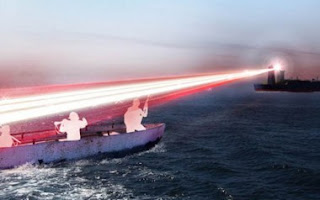According to the International Chamber Of Commerce’s International Maritime Bureau, 430 pirate attacks were reported worldwide in 2010, up from 406 in 2009. Already in the first 11 days of 2011, 15 attacks have been reported, including two hijackings and 41 people taken hostage. With pirates increasing their range of operations and their capabilities, BAE Systems conducted a study of pirate’s behavior and a company-wide capability survey to examine if they had anything that could help combat the growing piracy threat.
The researchers decided that the concept of a non-lethal laser, which would leave only temporary effects, to distract and deter potential attackers from a distance was the best approach, and conducted a number of experiments to assess the feasibility of the concept. Leveraging the capabilities of BAE’s Optics and Laser Technology Department, the research team has successfully demonstrated a suitable laser at the Pershore Trials Range in Worchester over a variety of distances and in a variety of conditions.
The laser beam demonstrated is capable of providing a visual warning to pirates at distances of over 2 km (1.24 miles), while at lesser distances it can sufficiently disorientate attackers so that they are unable to target their weapons effectively, similar to the Dazer Laser.
“The effect is similar to when a fighter pilot attacks from the direction of the sun. The glare from the laser is intense enough to make it impossible to aim weapons like AK47s or RPGs, but doesn’t have a permanent effect,” said Roy Evans, BAE Systems capability technology lead for laser photonic systems.
For the tests the researchers developed a bespoke Neodymium Yttrium Aluminium Garnet (Nd:YAG) laser, which they say is an effective deterrent at relatively low power levels. By utilizing targeting systems and changing beam patterns, the distraction effect can be made more pronounced and be used against multiple targets.
“We successfully showed that the laser works not just during the night, but also in full daylight. But, there are many more requirements to meet before placing a non-lethal laser weapon on commercial ships,” Evans added.
BAE says that when it is fitted on commercial ships, the laser distraction system could use its own targeting capability or integrate with existing ship radar and sensor systems to control the direction and power of the beam, allowing it to work semi-autonomously. It would also include security features to ensure that, if the pirates did manage to get aboard, they wouldn’t be able to use the laser.
“Laser distraction is part of a wider program of anti-piracy technologies being developed by BAE Systems, including radar systems, which utilizes expertise and knowledge from the military domain. The aim of the laser distraction project is now to develop a non-lethal deterrent to pirates, which has no lasting effects, which can work in a maritime environment, be operated by the crew at no risk, and be cost effective,” said Bryan Hore, BAE Systems business development manager and the lead for the anti-piracy program.
Source: gizmag
